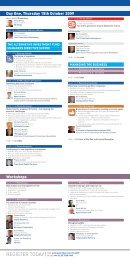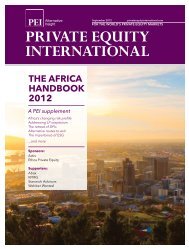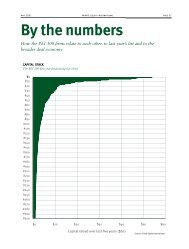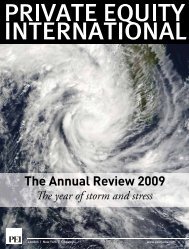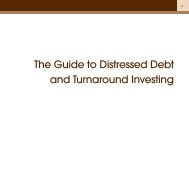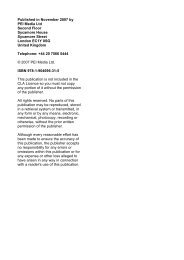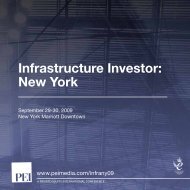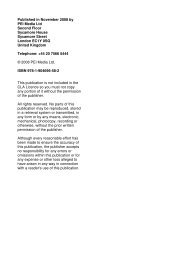Private equity in an insurance company's strategic asset ... - PEI Media
Private equity in an insurance company's strategic asset ... - PEI Media
Private equity in an insurance company's strategic asset ... - PEI Media
Create successful ePaper yourself
Turn your PDF publications into a flip-book with our unique Google optimized e-Paper software.
10<br />
<strong>Private</strong> <strong>equity</strong> <strong>in</strong> <strong>an</strong> <strong>in</strong>sur<strong>an</strong>ce comp<strong>an</strong>y’s<br />
<strong>strategic</strong> <strong>asset</strong> allocation<br />
By Paul Achleitner <strong>an</strong>d Stef<strong>an</strong> Albrecht, Alli<strong>an</strong>z 1<br />
Risk aspects discussed <strong>in</strong> this chapter:<br />
➲ How c<strong>an</strong> <strong>an</strong> <strong>in</strong>sur<strong>an</strong>ce comp<strong>an</strong>y determ<strong>in</strong>e its private <strong>equity</strong> allocation<br />
under a <strong>strategic</strong> <strong>asset</strong> allocation model?<br />
➲ What are the effects of the J-Curve on <strong>in</strong>sur<strong>an</strong>ce comp<strong>an</strong>ies establish<strong>in</strong>g a<br />
new private <strong>equity</strong> programme?<br />
➲ To what extent does a detailed underst<strong>an</strong>d<strong>in</strong>g of <strong>asset</strong>-liability m<strong>an</strong>agement<br />
<strong>in</strong>fluence <strong>an</strong> <strong>in</strong>sur<strong>an</strong>ce comp<strong>an</strong>y’s private <strong>equity</strong> allocation?<br />
➲ What impact do regulation, external rat<strong>in</strong>gs <strong>an</strong>d <strong>in</strong>ternal risk-capital requirements<br />
have on <strong>an</strong> <strong>in</strong>sur<strong>an</strong>ce comp<strong>an</strong>y’s private <strong>equity</strong> m<strong>an</strong>agement?<br />
Introduction<br />
Strategic <strong>asset</strong> allocation (SAA) is at the core of <strong>an</strong>y long-term <strong>in</strong>vestment programme<br />
<strong>an</strong>d largely determ<strong>in</strong>es its overall success. This well-known basic pr<strong>in</strong>ciple of <strong>in</strong>vest<strong>in</strong>g is<br />
even more import<strong>an</strong>t for <strong>in</strong>sur<strong>an</strong>ce comp<strong>an</strong>ies, which have not only to achieve satisfy<strong>in</strong>g<br />
long-term <strong>in</strong>vestment results, but also <strong>an</strong>d foremost, must meet their <strong>in</strong>sur<strong>an</strong>ce claims.<br />
Only when it considers both <strong>asset</strong>s <strong>an</strong>d liabilities at the same time c<strong>an</strong> <strong>an</strong> <strong>in</strong>sur<strong>an</strong>ce comp<strong>an</strong>y<br />
effectively m<strong>an</strong>age the requirements of its various stakeholders.<br />
SAA is embedded <strong>in</strong> <strong>an</strong>d depends upon the larger framework of <strong>asset</strong>-liability m<strong>an</strong>agement<br />
(ALM), which addresses a r<strong>an</strong>ge of topics. Among them are the <strong>an</strong>alysis <strong>an</strong>d optimisation<br />
of the <strong>in</strong>vestment decisions, <strong>an</strong>d most import<strong>an</strong>t, the maximisation of<br />
shareholder profit, while m<strong>an</strong>ag<strong>in</strong>g various risks such as liquidity, <strong>in</strong>terest rate, credit <strong>an</strong>d<br />
operational risks.<br />
In this chapter, beg<strong>in</strong>n<strong>in</strong>g with section 2, we discuss a simplified process to assist <strong>in</strong>sur<strong>an</strong>ce<br />
comp<strong>an</strong>ies <strong>in</strong> determ<strong>in</strong><strong>in</strong>g their private <strong>equity</strong> allocation under a <strong>strategic</strong> <strong>asset</strong> allocation<br />
model. We do so by present<strong>in</strong>g a multi-step approach where private <strong>equity</strong><br />
becomes part of the overall <strong>equity</strong> allocation <strong>in</strong> a more qualitative judgement. To this end,<br />
a thorough underst<strong>an</strong>d<strong>in</strong>g of all ALM-related characteristics is m<strong>an</strong>datory; these are<br />
1<br />
The authors are grateful to Thomas Ripfel, Dr. Christi<strong>an</strong> Stögbauer, Henock Teklu, <strong>an</strong>d Bri<strong>an</strong> Welker for<br />
helpful comments <strong>an</strong>d contributions.<br />
105
Part I: Risk aspects of limited partners<br />
addressed <strong>in</strong> some detail <strong>in</strong> section 3. In section 4 we outl<strong>in</strong>e the import<strong>an</strong>t regulatory,<br />
rat<strong>in</strong>gs <strong>an</strong>d risk-capital requirements relev<strong>an</strong>t for <strong>in</strong>sur<strong>an</strong>ce comp<strong>an</strong>ies with a focus on<br />
Europe<strong>an</strong> regulation. F<strong>in</strong>ally, section 5 offers a summary <strong>an</strong>d conclud<strong>in</strong>g remarks.<br />
Process to<br />
determ<strong>in</strong>e <strong>an</strong><br />
SAA <strong>in</strong>clud<strong>in</strong>g<br />
private <strong>equity</strong><br />
Determ<strong>in</strong><strong>in</strong>g <strong>an</strong> <strong>in</strong>sur<strong>an</strong>ce comp<strong>an</strong>y’s SAA is a complex <strong>an</strong>d <strong>in</strong>volved task. The SAA is a<br />
long-term recommendation about how to optimally allocate available <strong>asset</strong>s while consider<strong>in</strong>g<br />
expected liabilities. First of all, <strong>an</strong> <strong>in</strong>sur<strong>an</strong>ce comp<strong>an</strong>y must fully consider the<br />
required cash flows to meet future expected claims. In addition, <strong>in</strong> order to stay competitive<br />
compared to its peers, <strong>an</strong> <strong>in</strong>sur<strong>an</strong>ce comp<strong>an</strong>y must also achieve a satisfy<strong>in</strong>g return<br />
on its <strong>in</strong>vestments. Furthermore, these returns should not vary too much from year to<br />
year s<strong>in</strong>ce both policyholders <strong>an</strong>d shareholders prefer stable <strong>an</strong>d predictable <strong>in</strong>vestment<br />
profits <strong>an</strong>d returns.<br />
All these requirements me<strong>an</strong> that <strong>in</strong>sur<strong>an</strong>ce comp<strong>an</strong>ies have to const<strong>an</strong>tly look for ways<br />
to improve the risk-return profile of their <strong>in</strong>vestment portfolios, which is particularly<br />
import<strong>an</strong>t <strong>in</strong> a decl<strong>in</strong><strong>in</strong>g <strong>in</strong>terest rate environment. Obvious approaches <strong>in</strong>clude exploit<strong>in</strong>g<br />
structural opportunities <strong>in</strong> the capital markets, like the normally positive slope of the<br />
yield curve or to harvest illiquidity premiums of <strong>asset</strong> classes like real estate, private <strong>equity</strong><br />
or <strong>in</strong>frastructure <strong>in</strong>vestments, for example.<br />
Qu<strong>an</strong>titative<br />
vs. qualitative<br />
approaches<br />
The scope of this chapter does not permit us to discuss all topics relev<strong>an</strong>t to SAA. Rather<br />
we present a simplified SAA process <strong>an</strong>d discuss <strong>in</strong> more detail how to consider private<br />
<strong>equity</strong> <strong>in</strong> this context. A coherent qu<strong>an</strong>titative optimisation scheme consider<strong>in</strong>g all pert<strong>in</strong>ent<br />
aspects of private <strong>equity</strong> is often not available or reasonable. Instead, m<strong>an</strong>y<br />
<strong>in</strong>vestors follow a multi-step SAA process, whereby the overall <strong>equity</strong> allocation is determ<strong>in</strong>ed<br />
first <strong>an</strong>d then private <strong>equity</strong> is added later on, giv<strong>in</strong>g additional diversification benefits<br />
to listed <strong>equity</strong>. Consider<strong>in</strong>g <strong>in</strong>sur<strong>an</strong>ce comp<strong>an</strong>ies’ typically ‘small’ overall <strong>equity</strong><br />
allocation, the split between private <strong>an</strong>d listed <strong>equity</strong> may be made on a more qualitative<br />
basis, as the same underly<strong>in</strong>g macroeconomic factors, to a certa<strong>in</strong> extent, drive these<br />
<strong>equity</strong> types. Nevertheless, the decision on the private <strong>equity</strong> allocation must be done <strong>in</strong><br />
a well-<strong>in</strong>formed <strong>an</strong>d discipl<strong>in</strong>ed m<strong>an</strong>ner.<br />
Sophisticated approaches, which attempt to coherently model alternative <strong>asset</strong>s together<br />
with traditional <strong>asset</strong> classes, such as stocks or bonds, are not discussed <strong>in</strong> this chapter.<br />
Typically, these approaches lead to a multi-phase simulation, whereby the <strong>asset</strong><br />
returns <strong>an</strong>d correlations have to be coherently modelled 2 . In this way specific cash-flow<br />
characteristics, such as the J-Curve of private <strong>equity</strong> <strong>in</strong>vestments (see section 3), may<br />
even be <strong>in</strong>corporated. However, there are several drawbacks to these very <strong>in</strong>terest<strong>in</strong>g<br />
approaches. Evidently, they are quite <strong>in</strong>volved <strong>an</strong>d difficult to implement. More import<strong>an</strong>t,<br />
2<br />
See, for example, Terhaar, Staub <strong>an</strong>d S<strong>in</strong>ger (2003) <strong>an</strong>d Staub (2005), who use common underly<strong>in</strong>g factors<br />
to derive the covari<strong>an</strong>ces <strong>an</strong>d returns. Höcht, Ng, Wolf <strong>an</strong>d Zagst (2008) employ a Markov switch<strong>in</strong>g<br />
model, which also accounts for auto-correlation effects, <strong>an</strong>d calibrate it aga<strong>in</strong>st historical return series.<br />
Escobar, Hieber, Scherer <strong>an</strong>d Seco (2009) present a portfolio-optimisation scheme <strong>in</strong>clud<strong>in</strong>g default risk.<br />
106
<strong>Private</strong> <strong>equity</strong> <strong>in</strong> <strong>an</strong> <strong>in</strong>sur<strong>an</strong>ce comp<strong>an</strong>y’s <strong>strategic</strong> <strong>asset</strong> allocation<br />
these methods are basically <strong>asset</strong>-only optimisations, which do not <strong>in</strong>corporate the oftencomplex<br />
structure of <strong>in</strong>sur<strong>an</strong>ce claims <strong>an</strong>d liabilities. Particularly, for a with-profit life<br />
<strong>in</strong>sur<strong>an</strong>ce contract, the <strong>asset</strong>-liability <strong>in</strong>teraction dem<strong>an</strong>ds highly sophisticated ALM software<br />
packages that simulate the full bal<strong>an</strong>ce sheet of the <strong>in</strong>sur<strong>an</strong>ce comp<strong>an</strong>y over the<br />
whole lifetime of the contract, which often do not allow for a direct optimisation of the<br />
<strong>asset</strong> allocation. Rather, the user has to test <strong>an</strong>d <strong>an</strong>alyse various c<strong>an</strong>didate allocations to<br />
f<strong>in</strong>ally arrive at a recommendation for its SAA (by deploy<strong>in</strong>g a ‘what-if’ <strong>an</strong>alysis approach).<br />
Steps of <strong>an</strong><br />
SAA process<br />
The first step of <strong>an</strong>y SAA process requires a critical <strong>an</strong>d careful <strong>an</strong>alysis of the <strong>asset</strong><br />
structure <strong>an</strong>d the expected liability patterns. This ALM <strong>an</strong>alysis is a vast subject <strong>in</strong> itself<br />
<strong>an</strong>d too detailed to list here. It may suffice to mention that the long-term return requirements<br />
of the portfolio <strong>in</strong> general <strong>an</strong>d the return expectations for <strong>equity</strong> <strong>in</strong> particular<br />
should be understood. Additional factors to consider <strong>in</strong>clude the risk-bear<strong>in</strong>g capacity <strong>an</strong>d<br />
risk appetite as well as the operat<strong>in</strong>g profit <strong>an</strong>d liquidity needs that have to be identified.<br />
Another import<strong>an</strong>t po<strong>in</strong>t is a thorough <strong>in</strong>vestigation of the term structure of the expected<br />
liabilities to f<strong>in</strong>d the required key-rate durations of the <strong>asset</strong> portfolio. A simple duration-match<strong>in</strong>g<br />
is usually not adequate.<br />
The next po<strong>in</strong>t <strong>in</strong> the SAA process is the def<strong>in</strong>ition of the ma<strong>in</strong> <strong>asset</strong> classes be<strong>in</strong>g considered.<br />
We propose for ease <strong>an</strong>d practicability four ma<strong>in</strong> <strong>asset</strong> classes: government<br />
bonds (<strong>in</strong> various maturity buckets); corporate bonds; <strong>equity</strong>; <strong>an</strong>d real estate.<br />
Government bonds are assumed to be almost risk-free <strong>an</strong>d very liquid; they allow for keyrate<br />
duration-match<strong>in</strong>g of the liabilities. Corporate bonds, which may also <strong>in</strong>clude covered<br />
bonds, provide higher returns <strong>an</strong>d current <strong>in</strong>come from coupons. Equities allow reserves<br />
(unrealised capital ga<strong>in</strong>s <strong>an</strong>d losses (UCGL)) to be built up <strong>an</strong>d are l<strong>in</strong>ked to <strong>in</strong>flation <strong>an</strong>d<br />
the overall growth of the economy. Real estate delivers current <strong>in</strong>come through rent <strong>an</strong>d<br />
a protection aga<strong>in</strong>st <strong>in</strong>flation surprises. Depend<strong>in</strong>g on the <strong>in</strong>vestment structure, real<br />
estate also allows reserves to build up both from pl<strong>an</strong>ned book-value depreciation <strong>an</strong>d<br />
potential market-value appreciation. The reader should note that for ease we consider<br />
only one economy with a s<strong>in</strong>gle currency regime.<br />
S<strong>in</strong>ce the private <strong>equity</strong> allocation will be determ<strong>in</strong>ed later as part of the total <strong>equity</strong><br />
quota, a prospective private <strong>equity</strong> <strong>in</strong>vestor should, at the latest, now start to acquire a<br />
comprehensive underst<strong>an</strong>d<strong>in</strong>g of the <strong>asset</strong> class as far as it is necessary from a portfolio-construction<br />
po<strong>in</strong>t of view. The various peculiarities of private <strong>equity</strong> <strong>in</strong>vestments are<br />
discussed <strong>in</strong> section 3.<br />
Next, it is necessary to evaluate what we call ‘room for m<strong>an</strong>oeuvre’ for SAA. Various<br />
external constra<strong>in</strong>ts <strong>an</strong>d regulations – which are further discussed <strong>in</strong> section 4 – like solvency,<br />
account<strong>in</strong>g pr<strong>in</strong>ciples, tax laws <strong>an</strong>d rat<strong>in</strong>gs as well as <strong>in</strong>ternal risk-capital requirements<br />
c<strong>an</strong> severely limit the possibility to ch<strong>an</strong>ge the current <strong>asset</strong> allocation <strong>an</strong>d set<br />
constra<strong>in</strong>ts for the subsequent portfolio optimisation. As <strong>an</strong> aside, we note that we also<br />
collect necessary <strong>in</strong>formation to be able at a later stage to set some leeway for tactical<br />
<strong>asset</strong> allocation (TAA) bets around the still-to-be-determ<strong>in</strong>ed SAA. Liquidity <strong>an</strong>d operat<strong>in</strong>g<br />
profit needs should also to be taken <strong>in</strong>to account at this po<strong>in</strong>t. In particular, the specific<br />
107
Part I: Risk aspects of limited partners<br />
characteristics of the various exist<strong>in</strong>g or prospective illiquid allocations (eg real estate, private<br />
<strong>equity</strong>, mezz<strong>an</strong><strong>in</strong>e, <strong>in</strong>frastructure, renewable energy <strong>an</strong>d lo<strong>an</strong>s) are to be accounted<br />
for <strong>an</strong>d pl<strong>an</strong>ned for.<br />
Hav<strong>in</strong>g determ<strong>in</strong>ed the room for m<strong>an</strong>oeuvre, we c<strong>an</strong> endeavour to f<strong>in</strong>d <strong>an</strong> optimal portfolio<br />
allocation for our four ma<strong>in</strong> <strong>asset</strong> classes: government <strong>an</strong>d corporate bonds, <strong>equity</strong><br />
<strong>an</strong>d real estate. In the property <strong>an</strong>d casualty (P&C) bus<strong>in</strong>ess segment, this may be<br />
achieved with a Markowitz-<strong>in</strong>spired optimisation approach, possibly also consider<strong>in</strong>g the<br />
expected distribution <strong>an</strong>d term structure of future claims through a portfolio of zerocoupon<br />
bonds yield<strong>in</strong>g negative returns, which matches the key-rate durations of the liabilities.<br />
Thus, a proxy of the total net <strong>asset</strong> value is optimised under appropriate<br />
constra<strong>in</strong>ts. As already mentioned above, the situation is much more complicated for a<br />
with-profit life <strong>in</strong>sur<strong>an</strong>ce contract due to the typically complex <strong>asset</strong>-liability <strong>in</strong>teraction.<br />
However, by mak<strong>in</strong>g a r<strong>an</strong>ge of educated what-if <strong>an</strong>alyses us<strong>in</strong>g ALM software, a suitable<br />
SAA c<strong>an</strong> be determ<strong>in</strong>ed, which takes the various constra<strong>in</strong>ts <strong>in</strong>to account.<br />
Def<strong>in</strong><strong>in</strong>g the<br />
private <strong>equity</strong><br />
exposure<br />
The private <strong>equity</strong> exposure <strong>in</strong> relation to the overall <strong>equity</strong> allocation has to be def<strong>in</strong>ed<br />
consider<strong>in</strong>g various aspects like cash-flow pl<strong>an</strong>n<strong>in</strong>g or duration-match<strong>in</strong>g. Negative cash<br />
flows dur<strong>in</strong>g the first years of a fund, referred to as the J-Curve effect, generally limit the<br />
ability to <strong>in</strong>itially commit large portions of the portfolio <strong>an</strong>d must be pl<strong>an</strong>ned for <strong>in</strong> the<br />
context of a longer-term commitment strategy.<br />
S<strong>in</strong>ce the actual <strong>in</strong>vestments <strong>in</strong> portfolio comp<strong>an</strong>ies made by a private <strong>equity</strong> fund c<strong>an</strong><br />
be spread over a period of up to six years (the <strong>in</strong>vestment period), the target exposure<br />
should be def<strong>in</strong>ed at <strong>an</strong> early stage. It is import<strong>an</strong>t to clearly dist<strong>in</strong>guish between the<br />
commitment (cont<strong>in</strong>gent exposure to future draw-downs) <strong>an</strong>d the net <strong>asset</strong> value (NAV)<br />
(value of current <strong>in</strong>vestments). The latter should be taken as exposure.<br />
Build<strong>in</strong>g up a me<strong>an</strong><strong>in</strong>gful private <strong>equity</strong> exposure from scratch takes at least five years<br />
<strong>an</strong>d requires special cash-flow pl<strong>an</strong>n<strong>in</strong>g tools (these topics will be discussed <strong>in</strong> the next<br />
section <strong>in</strong> more detail). Careful pl<strong>an</strong>n<strong>in</strong>g <strong>an</strong>d a long-term, multi-year commitment strategy<br />
that largely avoid market tim<strong>in</strong>g are key criteria for success.<br />
Characteristics of<br />
private <strong>equity</strong><br />
relev<strong>an</strong>t for ALM<br />
Illiquidity, moderate<br />
reserve-build<strong>in</strong>g<br />
potential <strong>an</strong>d midterm<br />
<strong>in</strong>vestment<br />
duration<br />
<strong>Private</strong> <strong>equity</strong> is a complex <strong>asset</strong> class with m<strong>an</strong>y differences from common listed<br />
stocks 3 . One of the most prom<strong>in</strong>ent characteristics is the org<strong>an</strong>isation of the <strong>in</strong>vestment<br />
vehicles (funds) as limited partnerships 4 . An <strong>in</strong>vestor makes a commitment to a fund,<br />
which leads to a long-term engagement (at least ten years) without the option of <strong>an</strong> easy<br />
3<br />
4<br />
5<br />
For <strong>an</strong> <strong>in</strong>troduction <strong>an</strong>d overview on <strong>in</strong>vest<strong>in</strong>g <strong>in</strong> private <strong>equity</strong>, see, for example, B<strong>an</strong>ce (2004) or<br />
Gillig<strong>an</strong> <strong>an</strong>d Wright (2010)<br />
This is the prom<strong>in</strong>ent legal structure <strong>in</strong> the US or UK. Similar structures are used <strong>in</strong> other jurisdictions.<br />
Here we do not consider listed private <strong>equity</strong>, as it “does not reflect the risk & return characteristics of<br />
a private <strong>equity</strong> portfolio of a typical <strong>in</strong>stitutional <strong>in</strong>vestor”, see CEIOPS (2010b), Comment No. 167 by<br />
Capital Dynamics.<br />
108
<strong>Private</strong> <strong>equity</strong> <strong>in</strong> <strong>an</strong> <strong>in</strong>sur<strong>an</strong>ce comp<strong>an</strong>y’s <strong>strategic</strong> <strong>asset</strong> allocation<br />
early exit 5 ; hence the descriptor that private <strong>equity</strong> is a very illiquid <strong>asset</strong> class. This is not<br />
unlike other <strong>asset</strong> classes, such as real estate or private debt, where securities are not<br />
traded on <strong>an</strong> org<strong>an</strong>ised <strong>an</strong>d regulated market.<br />
Another difference to listed <strong>equity</strong> is the limited duration of a s<strong>in</strong>gle private <strong>equity</strong><br />
<strong>in</strong>vestment. Listed stocks c<strong>an</strong> be held over very long time periods, thus allow<strong>in</strong>g<br />
considerable reserves to be built up (UCGL calculated as the difference between market<br />
<strong>an</strong>d book value). This is <strong>an</strong> import<strong>an</strong>t feature particularly for the m<strong>an</strong>agement of<br />
with-profit life <strong>in</strong>sur<strong>an</strong>ce comp<strong>an</strong>ies. By realis<strong>in</strong>g UCGL, m<strong>an</strong>agement c<strong>an</strong> smooth<br />
the <strong>in</strong>sur<strong>an</strong>ce comp<strong>an</strong>y’s returns <strong>an</strong>d help to achieve the highly stable <strong>in</strong>vestment<br />
results expected by both shareholders <strong>an</strong>d customers. This is generally not possible <strong>in</strong><br />
private <strong>equity</strong> 6 s<strong>in</strong>ce the cash flows from both <strong>in</strong>vestments <strong>an</strong>d exits are <strong>in</strong>herently<br />
non-discretionary.<br />
<strong>Private</strong> <strong>equity</strong> <strong>in</strong>vestments also require special account<strong>in</strong>g expertise: Under IFRS the distributions<br />
are either treated as return of capital or operat<strong>in</strong>g profit, the latter be<strong>in</strong>g the<br />
case for divestments declared by the fund as dividends. In local GAAP, <strong>an</strong> <strong>in</strong>sur<strong>an</strong>ce comp<strong>an</strong>y<br />
may have some flexibility to steer the distributions 7 .<br />
Another key po<strong>in</strong>t <strong>in</strong> ALM is the key-rate duration-match<strong>in</strong>g of <strong>asset</strong>s with liabilities.<br />
Although the life of a private <strong>equity</strong> fund (limited partnership) is generally ten years, the<br />
duration of cash flows is on average between four <strong>an</strong>d five years 8 . <strong>Private</strong> <strong>equity</strong> <strong>in</strong>vestments<br />
may not adequately cover very long-term liabilities, <strong>an</strong>d will entail some re<strong>in</strong>vestment<br />
risk. Another import<strong>an</strong>t consequence of the mid-term average <strong>in</strong>vestment duration<br />
is <strong>an</strong> only moderate potential for <strong>in</strong>flation protection.<br />
R<strong>an</strong>dom, but<br />
predictable<br />
cash flows with<br />
J-Curve pattern<br />
As mentioned above, the stochastic <strong>an</strong>d non-discretionary nature of private <strong>equity</strong> cash<br />
flows poses a considerable challenge for <strong>in</strong>vestors. Unless <strong>an</strong> allocation to private <strong>equity</strong><br />
is so small that cash calls <strong>an</strong>d distributions c<strong>an</strong> be served out of <strong>an</strong> <strong>in</strong>sur<strong>an</strong>ce comp<strong>an</strong>y’s<br />
cash account, a careful monitor<strong>in</strong>g of the past <strong>an</strong>d sophisticated pl<strong>an</strong>n<strong>in</strong>g for future cash<br />
flows is essential for a responsible <strong>in</strong>vestor 9 . However, <strong>in</strong>vestors should not overestimate<br />
the possibility to actually m<strong>an</strong>age, that is, swiftly adjust by buy<strong>in</strong>g or sell<strong>in</strong>g, their private<br />
<strong>equity</strong> exposure. The NAV exposure is basically illiquid <strong>an</strong>d it c<strong>an</strong> be properly pl<strong>an</strong>ned<br />
with<strong>in</strong> certa<strong>in</strong> r<strong>an</strong>ges of confidence <strong>in</strong> adv<strong>an</strong>ce, but not subst<strong>an</strong>tially altered <strong>in</strong> a short<br />
period of time.<br />
6<br />
7<br />
8<br />
9<br />
Here we disregard captive direct funds, which allow some discretion <strong>in</strong> the tim<strong>in</strong>g of the cash flows<br />
(<strong>in</strong>vestment <strong>an</strong>d exit decisions), as usually <strong>in</strong>sur<strong>an</strong>ce comp<strong>an</strong>ies only <strong>in</strong>vest directly <strong>in</strong> external funds<br />
or <strong>in</strong>directly <strong>in</strong> a fund of funds.<br />
For example, under Germ<strong>an</strong> HGB it is possible to re<strong>in</strong>vest the distributions <strong>in</strong>to the special hold<strong>in</strong>g comp<strong>an</strong>y<br />
usually established for a fund of funds structure. This allows control <strong>an</strong>d tim<strong>in</strong>g of the f<strong>in</strong>al distribution<br />
pay-outs, which are then recognised as dividends.<br />
See, for example, Rouv<strong>in</strong>ez (2003) or Lopez-de-Sil<strong>an</strong>es Phalippou <strong>an</strong>d Gottschalg (2009), who note that<br />
“returns are concentrated <strong>in</strong> short-held <strong>in</strong>vestments averag<strong>in</strong>g 79 percent for <strong>in</strong>vestments held less<br />
th<strong>an</strong> two years <strong>an</strong>d 10 percent for those held over four years”.<br />
See, for example, Meyer <strong>an</strong>d Mathonet (2005) or the chapters 1, 3 <strong>an</strong>d 6 of this book.<br />
109
Part I: Risk aspects of limited partners<br />
In particular, when build<strong>in</strong>g up a new private <strong>equity</strong> portfolio, <strong>an</strong> <strong>in</strong>vestor is exposed to the<br />
famous J-Curve. Dur<strong>in</strong>g the <strong>in</strong>itial phase, the fund’s <strong>in</strong>ternal rate of return (IRR), total value<br />
to paid-<strong>in</strong> (TVPI) <strong>an</strong>d net cash flows are all negative 10 . Diller <strong>an</strong>d Kaserer (2005) report that<br />
the payback period – the time until the net cumulative cash flows become positive – is<br />
around 7.5 to 7.8 years. On average, <strong>in</strong> the first four years, private <strong>equity</strong> funds do not provide<br />
signific<strong>an</strong>t current <strong>in</strong>come as <strong>in</strong>vestments <strong>in</strong> bonds or real estate would provide.<br />
A private <strong>equity</strong> programme should follow a multi-year pl<strong>an</strong>. In fact, if we assume for simplicity<br />
to commit the same amount each year, it takes around ten years to reach a steady<br />
state, <strong>in</strong> which the overall portfolio is not ch<strong>an</strong>g<strong>in</strong>g signific<strong>an</strong>tly from year to year. In<br />
essence, patience is a virtue for a private <strong>equity</strong> <strong>in</strong>vestor.<br />
Stale pric<strong>in</strong>g<br />
requires adjustment<br />
of volatilities <strong>an</strong>d<br />
correlations<br />
An import<strong>an</strong>t aspect of private <strong>equity</strong> returns is the phenomenon of stale pric<strong>in</strong>g. This<br />
characteristic was first described <strong>an</strong>d <strong>in</strong>vestigated for real estate <strong>an</strong>d hedge funds <strong>an</strong>d<br />
later adapted to private <strong>equity</strong> 11 . Due to <strong>in</strong>frequent <strong>an</strong>d appraised estimates of a fund’s<br />
NAV, private <strong>equity</strong> return times series, which are provided, for example, by Thomson<br />
Venture Economics, suffer from smoothed <strong>an</strong>d delayed adjustments to developments <strong>in</strong><br />
the <strong>equity</strong> markets. Volatilities directly calculated from these time series are underestimated<br />
by a factor of around two as shown <strong>in</strong> Table 10.1 12 . Us<strong>in</strong>g the Sharpe Ratio<br />
approach, we f<strong>in</strong>d that both EU LBOs <strong>an</strong>d US LBOs, as well as US Mezz<strong>an</strong><strong>in</strong>e, produce<br />
superior risk-adjusted returns compared to public <strong>equity</strong>.<br />
Correlations also need to be adjusted. However, the approach by Getm<strong>an</strong>sky, Lo <strong>an</strong>d<br />
Makarov (2004) is statistically less reliable for this purpose <strong>an</strong>d may not lead to valid<br />
Table 10.1: Me<strong>an</strong> return, naive <strong>an</strong>d unsmoothed volatility, <strong>an</strong>d Sharpe Ratio<br />
of quarterly private <strong>an</strong>d public <strong>equity</strong> return time series for the period<br />
Q1-1985 to Q4-2008<br />
All funds EU LBOs EU VC US LBOs US Mezz. US VC S&P 500<br />
Me<strong>an</strong> return 14% 6% 15% 10% 14% 9%<br />
Naive volatility 11% 10% 11% 9% 17% 17%<br />
Unsmoothed volatility 20% 17% 20% 13% 34% 17%<br />
Sharpe ratio 50% 12% 55% 46% 29% 29%<br />
Note: The private <strong>equity</strong> returns consider all active funds of all maturities dur<strong>in</strong>g each time step <strong>an</strong>d are net of fund fees <strong>an</strong>d carry.<br />
The naive volatility is directly calculated from the time series, while the unsmoothed volatility is adjusted follow<strong>in</strong>g Getm<strong>an</strong>sky, Lo <strong>an</strong>d<br />
Makarov (2004). The risk-free rate is set to 4% for the Sharpe Ratio, which uses the unsmoothed volatility.<br />
Source: Thomson Reuters Venture Economics, Thomson Reuters Datastream, own calculations.<br />
10<br />
See, for example, Meyer <strong>an</strong>d Mathonet (2005).<br />
11<br />
See, for example, Geltner (1990), Getm<strong>an</strong>sky, Lo <strong>an</strong>d Makarov (2004), Conroy <strong>an</strong>d Harris (2007) or chapter<br />
1 of this book.<br />
12<br />
This is also confirmed by CEIOPS (2010b), Comment No. 168 by Partners Group AG.<br />
110
<strong>Private</strong> <strong>equity</strong> <strong>in</strong> <strong>an</strong> <strong>in</strong>sur<strong>an</strong>ce comp<strong>an</strong>y’s <strong>strategic</strong> <strong>asset</strong> allocation<br />
results. Indeed, due to <strong>an</strong> average <strong>in</strong>vestment duration of over four years for private <strong>equity</strong><br />
deals, it is more appropriate to deduce the correlation of private <strong>equity</strong> with listed<br />
stocks from structural longer-term economic reason<strong>in</strong>g, which leads to fairly high figures.<br />
Terhaar, Staub <strong>an</strong>d S<strong>in</strong>ger (2003), for example, give a value of 0.9 for the correlation<br />
between US LBOs <strong>an</strong>d US equities.<br />
There are several implications of stale pric<strong>in</strong>g for ALM. First, tak<strong>in</strong>g naive volatilities <strong>an</strong>d<br />
correlations <strong>in</strong> a portfolio optimisation overstates the risk-return profile <strong>an</strong>d diversification<br />
benefits of private <strong>equity</strong>. Second, although the naive volatility does not reflect the underly<strong>in</strong>g<br />
economic risk of private <strong>equity</strong> <strong>in</strong>vestments, it is the volatility directly <strong>in</strong>ferred from<br />
the fund NAVs <strong>an</strong>d cash flows reported by the fund m<strong>an</strong>agers. Consequently, the naive<br />
volatility is accounted for on the <strong>in</strong>sur<strong>an</strong>ce bal<strong>an</strong>ce sheet. <strong>Private</strong> <strong>equity</strong> <strong>in</strong>vestors benefit<br />
from delayed <strong>an</strong>d smoothed reactions to market crashes, giv<strong>in</strong>g shorter-term diversification<br />
adv<strong>an</strong>tages when particularly needed <strong>an</strong>d enjoy a more stable bal<strong>an</strong>ce sheet.<br />
These benefits will, however, gradually disappear with the adoption of more str<strong>in</strong>gent<br />
mark-to-market valuations guidel<strong>in</strong>es as stated <strong>in</strong> the new FAS 157 regulations.<br />
Returns need<br />
to be adjusted<br />
for leverage<br />
<strong>an</strong>d illiquidity<br />
Perhaps the most discussed topics <strong>in</strong> private <strong>equity</strong> are the reported historical fund<br />
returns (IRRs <strong>an</strong>d TVPIs). Generally, funds do not publicly publish their returns. Therefore,<br />
<strong>in</strong>vestors c<strong>an</strong> either use proprietary <strong>in</strong>-house databases, which c<strong>an</strong> be built up from data<br />
received dur<strong>in</strong>g fund due diligence <strong>an</strong>d from their own commitments, or resort to data<br />
collected by commercial data providers such as Thomson Venture Economics. In this<br />
chapter, we concentrate on some aspects of private <strong>equity</strong> returns which are of particular<br />
<strong>in</strong>terest <strong>in</strong> the context of ALM <strong>an</strong>d portfolio optimisation, namely how to compare private<br />
<strong>equity</strong> with public <strong>equity</strong> returns on a risk-adjusted basis <strong>an</strong>d how reliably <strong>an</strong> <strong>in</strong>vestor<br />
c<strong>an</strong> expect to avoid badly perform<strong>in</strong>g funds.<br />
As the letter ‘L’ clearly st<strong>an</strong>ds for leverage <strong>in</strong> LBO 13 , leverage is <strong>an</strong> import<strong>an</strong>t part of the bus<strong>in</strong>ess<br />
model for buyout funds. In fact, Achleitner et al (2010) f<strong>in</strong>d that one-third of the overall<br />
value creation (def<strong>in</strong>ed as ‘TVPI-1’) is due to leverage 14 , while operational improvement<br />
accounts for 46 percent. The rest is multiple exp<strong>an</strong>sion (18 percent) <strong>an</strong>d a mixture of operational<br />
improvement <strong>an</strong>d multiple exp<strong>an</strong>sion (4 percent). Thus, broadly speak<strong>in</strong>g, around onethird<br />
of private <strong>equity</strong> IRR is also due to simple leverage. This fact should be accounted for<br />
when compar<strong>in</strong>g private with public returns. Us<strong>in</strong>g <strong>an</strong> elaborate approach, Phalippou <strong>an</strong>d<br />
Gottschalg (2009) f<strong>in</strong>d that the risk adjustment for leverage amounts to 3 percent <strong>an</strong>nually 15 .<br />
They also report that “the market beta is 1.3 <strong>an</strong>d buyouts resemble small-value stocks”.<br />
The next import<strong>an</strong>t dist<strong>in</strong>ctive return-driver is the illiquidity premium, which amounts to<br />
around 3 percent <strong>an</strong>nually 16 . Obviously, this is earned without <strong>an</strong>y achievement by the<br />
13<br />
We focus on buyout <strong>an</strong>d disregard venture capital as it is less relev<strong>an</strong>t for m<strong>an</strong>y <strong>in</strong>stitutional <strong>in</strong>vestors.<br />
14<br />
Note that this implies that one-third of the perform<strong>an</strong>ce fee, also known as carry, is due to simple leverage<br />
effects.<br />
15<br />
This value has to be understood as negative alpha on the fund IRR. Note that illiquidity is not accounted<br />
for yet.<br />
16<br />
See Staub (2003) or Fr<strong>an</strong>zoni, Nowak <strong>an</strong>d Phalippou (2010).<br />
111
Part I: Risk aspects of limited partners<br />
Table 10.2: Me<strong>an</strong> return, naive <strong>an</strong>d unsmoothed volatility, <strong>an</strong>d Sharpe Ratio<br />
of quarterly private <strong>an</strong>d public <strong>equity</strong> return time series for the period Q1-<br />
1985 to Q4-2008<br />
Top 75% of funds EU LBOs EU VC US LBOs US Mezz. US VC S&P 500<br />
Me<strong>an</strong> return 17% 8% 18% 13% 17% 9%<br />
Naive volatility 13% 11% 11% 10% 18% 17%<br />
Unsmoothed volatility 23% 19% 21% 15% 36% 17%<br />
Sharpe ratio 57% 21% 67% 60% 36% 29%<br />
Note: Bottom quartile funds are excluded. See Table 10.1 for further comments.<br />
Source: Thomson Reuters Venture Economics, Thomson Reuters Datastream, own calculations.<br />
fund m<strong>an</strong>ager <strong>an</strong>d must also be deducted <strong>in</strong> order to have a fair comparison between private<br />
<strong>an</strong>d public returns.<br />
However, there is some good news for private <strong>equity</strong> fund <strong>in</strong>vestors. Various studies have<br />
found remarkable perform<strong>an</strong>ce persistence among private <strong>equity</strong> funds 17 . Aigner et al<br />
(2008) determ<strong>in</strong>e the probability that a top-quartile fund m<strong>an</strong>ager will aga<strong>in</strong> be top quartile<br />
with his successor fund r<strong>an</strong>g<strong>in</strong>g somewhere between 33 percent <strong>an</strong>d 42 percent,<br />
depend<strong>in</strong>g on the applied perform<strong>an</strong>ce measure. Phalippou <strong>an</strong>d Gottschalg (2009) note<br />
“that prior fund perform<strong>an</strong>ce actually subsumes all other fund characteristics <strong>in</strong> expla<strong>in</strong><strong>in</strong>g<br />
fund perform<strong>an</strong>ce”. Strongly underperform<strong>in</strong>g funds may be largely avoided by a fundselection<br />
scheme exclud<strong>in</strong>g the fund m<strong>an</strong>agers with the worst return history.<br />
Consequently, it may be justifiable to exclude the bottom-quartile funds from historical<br />
perform<strong>an</strong>ce <strong>an</strong>alyses. In do<strong>in</strong>g so, the me<strong>an</strong> return of US buyout funds <strong>in</strong>creases, for<br />
example, from 15 percent to 18 percent, as c<strong>an</strong> be seen <strong>in</strong> Table 10.2. Furthermore, only<br />
EU VC has now a lower Sharpe Ratio th<strong>an</strong> public <strong>equity</strong>, which underl<strong>in</strong>es the capability<br />
of private <strong>equity</strong> to generate superior risk-adjusted returns.<br />
External fund of funds m<strong>an</strong>agers are often m<strong>an</strong>dated s<strong>in</strong>ce the aforementioned selection<br />
process is quite labour-<strong>in</strong>tensive. Furthermore, a successful private <strong>equity</strong> programme<br />
does not only require avoid<strong>an</strong>ce of bad funds, but also hav<strong>in</strong>g access to<br />
top-perform<strong>in</strong>g funds, which external fund of funds m<strong>an</strong>agers promise to provide. The<br />
additional fund of funds structure adds <strong>an</strong>other fee layer of around 1 percent per<br />
<strong>an</strong>num (plus typically 5 percent carry) 18 . However, a good fund of funds m<strong>an</strong>ager c<strong>an</strong><br />
pay for itself by earn<strong>in</strong>g higher net returns (after payment of all costs <strong>an</strong>d fees) th<strong>an</strong> <strong>an</strong><br />
<strong>in</strong>ternal team might generate 19 .<br />
17<br />
See, for example, Rouv<strong>in</strong>ez (2006), Brigl et al (2008), Aigner et al (2008) or Phalippou <strong>an</strong>d Gottschalg<br />
(2009).<br />
18<br />
In comparison, Phalippou <strong>an</strong>d Gottschalg (2009) f<strong>in</strong>d that the fees of a typical private <strong>equity</strong> direct fund<br />
amount to 6% per <strong>an</strong>num.<br />
19<br />
See PiperJaffray (2003).<br />
112
<strong>Private</strong> <strong>equity</strong> <strong>in</strong> <strong>an</strong> <strong>in</strong>sur<strong>an</strong>ce comp<strong>an</strong>y’s <strong>strategic</strong> <strong>asset</strong> allocation<br />
Regulatory, rat<strong>in</strong>g<br />
<strong>an</strong>d risk-capital<br />
requirements for<br />
private <strong>equity</strong><br />
Insur<strong>an</strong>ce comp<strong>an</strong>ies’ <strong>in</strong>vestment decisions are strongly <strong>in</strong>fluenced by a r<strong>an</strong>ge of external<br />
constra<strong>in</strong>ts <strong>an</strong>d regulations, notably solvency, external rat<strong>in</strong>gs <strong>an</strong>d <strong>in</strong>ternal risk-capital<br />
requirements. In this section we focus on Europe<strong>an</strong> regulation. Import<strong>an</strong>t aspects like<br />
the implications of different tax regimes for private <strong>equity</strong> <strong>in</strong> the Europe<strong>an</strong> Union or of<br />
local account<strong>in</strong>g pr<strong>in</strong>ciples on the m<strong>an</strong>agement of UCGL, which have already been partly<br />
discussed <strong>in</strong> section 3.1, are not addressed s<strong>in</strong>ce they are rather country-specific.<br />
Investments by f<strong>in</strong><strong>an</strong>cial <strong>in</strong>stitutions <strong>in</strong> private <strong>equity</strong> are governed by different regulatory<br />
regimes: Insur<strong>an</strong>ce <strong>an</strong>d re<strong>in</strong>sur<strong>an</strong>ce comp<strong>an</strong>ies are covered by Solvency II 20 <strong>an</strong>d b<strong>an</strong>ks<br />
by the Capital Adequacy Directive (CAD III) 21 .<br />
Follow<strong>in</strong>g a request by the Europe<strong>an</strong> Commission to specify the implementation of<br />
Solvency II, the Committee of Europe<strong>an</strong> Insur<strong>an</strong>ce <strong>an</strong>d Occupational Pensions Supervisors<br />
(CEIOPS) has proposed risk-capital charges both for listed (EEA or OECD countries) <strong>an</strong>d for<br />
private <strong>equity</strong> <strong>in</strong>vestments (as part of the so called ‘other’ <strong>equity</strong> class) with<strong>in</strong> the st<strong>an</strong>dard<br />
formula 22 . CEIOPS has calculated a 99.5 percent empirical Value at Risk (VaR) for certa<strong>in</strong><br />
<strong>in</strong>dices used to reflect the perform<strong>an</strong>ce of the accord<strong>in</strong>g <strong>equity</strong> segment. This results <strong>in</strong> a<br />
capital charge of 55 percent for private <strong>equity</strong> on a st<strong>an</strong>dalone basis. The risks related to private<br />
<strong>equity</strong> are mapped to the market-risk module. As a reaction to the <strong>in</strong>dustry’s reason<strong>in</strong>g<br />
regard<strong>in</strong>g this suggestion, the Europe<strong>an</strong> Commission has reduced this value to 49 percent<br />
dur<strong>in</strong>g the consultation period of the Qu<strong>an</strong>titative Impact Study 5. 23 Employ<strong>in</strong>g <strong>in</strong>ternal models,<br />
which have to be signed off by the supervisor, c<strong>an</strong> lead to lower charges th<strong>an</strong> the st<strong>an</strong>dard<br />
Solvency II formula. In addition, diversification effects <strong>an</strong>d risk mitigation through<br />
shar<strong>in</strong>g of potential losses with policyholders will further reduce the effective risk charge.<br />
Similar to Solvency II, capital charges are also differentiated accord<strong>in</strong>g to the approach<br />
chosen <strong>in</strong> the CAD III regulation. For the most adv<strong>an</strong>ced approach (PD/LGD approach 24 )<br />
the capital charges r<strong>an</strong>ge from 12.6 percent to 17.4 percent. In chapter 20 of this book,<br />
Thomas Meyer discusses <strong>an</strong>d comments <strong>in</strong> some length on CAD III. Accord<strong>in</strong>gly, we will<br />
simply summarise the differences between Solvency II <strong>an</strong>d CAD III <strong>in</strong> Table 10.3.<br />
Compar<strong>in</strong>g Solvency II to CAD III regulation for private <strong>an</strong>d listed <strong>equity</strong>, it becomes clear<br />
that <strong>equity</strong> <strong>in</strong>vestments are treated quite differently <strong>in</strong> the two regulatory approaches.<br />
This is true for both the relationship between private <strong>equity</strong> <strong>an</strong>d listed <strong>equity</strong> <strong>an</strong>d also at<br />
the absolute level.<br />
Apparently, b<strong>an</strong>k<strong>in</strong>g <strong>an</strong>d <strong>in</strong>sur<strong>an</strong>ce <strong>in</strong>dustry regulators have quite diverg<strong>in</strong>g op<strong>in</strong>ions on<br />
the risk<strong>in</strong>ess of private <strong>equity</strong> <strong>in</strong>vestments 25 . This fact does not only stem from the spe-<br />
20<br />
See Europe<strong>an</strong> Parliament, Council (2009). Currently the Solvency II regulations are <strong>in</strong> discussion; for the<br />
time be<strong>in</strong>g Solvency I is the effective regulation.<br />
21<br />
See Europe<strong>an</strong> Parliament, Council (2006). The accord<strong>in</strong>g <strong>in</strong>ternational st<strong>an</strong>dard is codified <strong>in</strong> Basel II<br />
(Basel II (2006)).<br />
22<br />
See CEIOPS (2010a).<br />
23<br />
Europe<strong>an</strong> Commission (2010).<br />
24<br />
PD/LGD st<strong>an</strong>ds for ‘probability of default / loss-given default’.<br />
25<br />
There are even differences regard<strong>in</strong>g capital charges with<strong>in</strong> the b<strong>an</strong>k<strong>in</strong>g specific regulations CAD III <strong>an</strong>d<br />
Basel II.<br />
113
Part I: Risk aspects of limited partners<br />
Table 10.3: Regulatory capital requirements: Solvency II vs. CAD III.<br />
The Solvency II charge is before diversification as proposed by the<br />
st<strong>an</strong>dard formula<br />
<strong>Private</strong> <strong>equity</strong><br />
Listed <strong>equity</strong><br />
Solvency II<br />
CAD III<br />
(floors)<br />
49% 39%<br />
Internal rat<strong>in</strong>gs-based – Simple 15.2%–29.6% 23.2%<br />
Internal rat<strong>in</strong>gs-based – PD/LGD 12.6%–17.4% 6.1%<br />
Note: This st<strong>an</strong>dard value is subject to <strong>an</strong> additional correction factor represent<strong>in</strong>g the difference between the current value of the <strong>equity</strong><br />
<strong>in</strong>dex <strong>an</strong>d <strong>an</strong> average of historical values, which dampens the effect of short-term fluctuations. The CAD III-values for the PD/LGD<br />
approach are based on the risk-weight formula <strong>an</strong>d the def<strong>in</strong>ed <strong>equity</strong> floor values for PD, LGD <strong>an</strong>d maturity <strong>in</strong> the CAD-directive.<br />
Additionally, a correlation adjustment factor for small caps is considered (Europe<strong>an</strong> Parliament, Council (2006), pages 96f <strong>an</strong>d 105f).<br />
Generally, the r<strong>an</strong>ges depend on the degree of diversification <strong>an</strong>d the gr<strong>an</strong>ularity of the private <strong>equity</strong> portfolio or the regularity of the<br />
<strong>an</strong>nual cash flows.<br />
cial characteristics of private <strong>equity</strong> be<strong>in</strong>g a dist<strong>in</strong>ctive hybrid <strong>asset</strong> with both market- <strong>an</strong>d<br />
credit-risk features, but also from the varied success of private <strong>equity</strong> <strong>in</strong>dustry lobby<br />
groups for lower risk-capital charges 26 .<br />
Rat<strong>in</strong>gs agencies have also <strong>in</strong>cluded private <strong>equity</strong> <strong>in</strong> their frameworks <strong>an</strong>d developed<br />
specific risk-capital charges. St<strong>an</strong>dard & Poor’s, for example, sets the Europe<strong>an</strong> Capital<br />
Adequacy Factors for private <strong>equity</strong> at 75 percent <strong>an</strong>d for Europe<strong>an</strong> <strong>equity</strong> at 32 percent,<br />
both for a s<strong>in</strong>gle-A target rat<strong>in</strong>g 27 . Clearly, St<strong>an</strong>dard & Poor’s views private <strong>equity</strong> as much<br />
riskier th<strong>an</strong> listed <strong>equity</strong>.<br />
As <strong>an</strong> example of how the <strong>in</strong>ternal economic risk-capital assignment on a st<strong>an</strong>dalone<br />
basis c<strong>an</strong> be deferred, we use the un-smoothed volatilities for EU <strong>an</strong>d US LBOs from<br />
Table 10.1. Tak<strong>in</strong>g a st<strong>an</strong>dard VaR approach under the assumption of normally distributed<br />
returns, the risk-capital factor amounts to 55 percent for the 99.93 percent qu<strong>an</strong>tile over<br />
a one-year horizon, which is commensurate with a s<strong>in</strong>gle-A rat<strong>in</strong>g. Thus, the <strong>in</strong>vestor<br />
should allocate a risk capital of 55 percent of the NAV for a well-diversified private <strong>equity</strong><br />
portfolio. This is similar or even higher th<strong>an</strong> for listed <strong>equity</strong> <strong>in</strong>dices <strong>an</strong>d compares well<br />
with the Solvency II requirements.<br />
For a more ref<strong>in</strong>ed <strong>in</strong>ternal risk-capital modell<strong>in</strong>g, it is advisable to def<strong>in</strong>e additional private<br />
<strong>equity</strong> sub-<strong>asset</strong> classes with comparatively low-risk profiles – like <strong>in</strong>frastructure <strong>in</strong>vestments<br />
– for which risk-capital charges lower th<strong>an</strong> the proposed regulatory capital charges<br />
c<strong>an</strong> be applied, based on a thorough <strong>an</strong>alysis of the essential risk drivers of each <strong>in</strong>vestment.<br />
Of course such a procedure has to be accomp<strong>an</strong>ied by clear <strong>in</strong>vestment guidel<strong>in</strong>es,<br />
strong corporate govern<strong>an</strong>ce <strong>an</strong>d a thorough risk-controll<strong>in</strong>g <strong>an</strong>d m<strong>an</strong>agement process.<br />
Recent evidence from the latest recession start<strong>in</strong>g <strong>in</strong> 2008 shows relatively few default<br />
events from private <strong>equity</strong>-backed comp<strong>an</strong>ies 28 , <strong>in</strong>dicat<strong>in</strong>g the ability of private <strong>equity</strong><br />
26<br />
See chapter 20 for further comments <strong>an</strong>d details.<br />
27<br />
See St<strong>an</strong>dard & Poor’s (2008).<br />
28<br />
See Thomas (2010).<br />
114
<strong>Private</strong> <strong>equity</strong> <strong>in</strong> <strong>an</strong> <strong>in</strong>sur<strong>an</strong>ce comp<strong>an</strong>y’s <strong>strategic</strong> <strong>asset</strong> allocation<br />
funds to mitigate credit risk through deal selection (preferr<strong>in</strong>g cash flow-strong comp<strong>an</strong>ies),<br />
operational improvements <strong>an</strong>d good ref<strong>in</strong><strong>an</strong>c<strong>in</strong>g capabilities.<br />
In the context of portfolio optimisation, a proposed new <strong>strategic</strong> <strong>asset</strong> allocation should<br />
fulfil all relev<strong>an</strong>t constra<strong>in</strong>ts <strong>an</strong>d capital requirements under the market conditions <strong>an</strong>d<br />
the risk capital available at the time of the recommendation. Of course, it is possible to<br />
make cont<strong>in</strong>gent proposals (eg suggest<strong>in</strong>g a new <strong>asset</strong> allocation under the condition of<br />
a severe <strong>equity</strong> markets drop). However, this relates more to a tactical view th<strong>an</strong> a longterm<br />
unconditional SAA.<br />
Additionally, <strong>an</strong> <strong>in</strong>sur<strong>an</strong>ce comp<strong>an</strong>y may require various <strong>in</strong>ternal stress-tests, like <strong>in</strong>terest<br />
up-shifts or down-shifts <strong>an</strong>d/or <strong>equity</strong> market drops. These stress-tests are applied on the<br />
solvency <strong>an</strong>d rat<strong>in</strong>g models. Ideally, a current <strong>an</strong>d a proposed <strong>asset</strong> allocation should survive<br />
these stress-tests. In this way, the <strong>in</strong>sur<strong>an</strong>ce comp<strong>an</strong>y c<strong>an</strong> ensure that its rat<strong>in</strong>g is<br />
not at risk either under the current or the proposed new <strong>asset</strong> allocation.<br />
Summary <strong>an</strong>d<br />
conclud<strong>in</strong>g<br />
remarks<br />
The <strong>in</strong>clusion of private <strong>equity</strong> <strong>in</strong> <strong>an</strong> <strong>in</strong>sur<strong>an</strong>ce comp<strong>an</strong>y’s SAA is a multi-step process,<br />
which dem<strong>an</strong>ds separate approaches for the P&C <strong>an</strong>d life bus<strong>in</strong>ess segments.<br />
Particularly, the <strong>in</strong>tricate <strong>asset</strong>-liability <strong>in</strong>teraction of a with-profit life <strong>in</strong>sur<strong>an</strong>ce contract<br />
requires sophisticated ALM tools to determ<strong>in</strong>e <strong>an</strong> optimal <strong>asset</strong> allocation, while <strong>in</strong> the<br />
P&C case, a Markowitz-<strong>in</strong>spired optimisation approach is sufficient for our purposes.<br />
In view of the typically low total-<strong>equity</strong> allocation, we suggest a simplified SAA process<br />
with only four <strong>strategic</strong> <strong>asset</strong> classes: government bonds, corporate bonds, <strong>equity</strong>, <strong>an</strong>d<br />
real estate. At the first stage, we determ<strong>in</strong>e <strong>an</strong> optimal <strong>asset</strong> allocation tak<strong>in</strong>g the room<br />
for m<strong>an</strong>oeuvre – determ<strong>in</strong>ed by regulatory, rat<strong>in</strong>g <strong>an</strong>d risk-capital constra<strong>in</strong>ts – <strong>in</strong>to<br />
account. Liquidity <strong>an</strong>d operat<strong>in</strong>g profit requirements also have to be considered. In the<br />
second step, we assign a part of the overall <strong>equity</strong> quota to private <strong>equity</strong>.<br />
Investors must have a good underst<strong>an</strong>d<strong>in</strong>g of the characteristics of private <strong>equity</strong>. For<br />
example, cash calls <strong>an</strong>d distributions are at the discretion of the private <strong>equity</strong> fund m<strong>an</strong>ager.<br />
This fact impedes the ability to m<strong>an</strong>age the <strong>in</strong>vestment results by deliberately realis<strong>in</strong>g<br />
UCGL. <strong>Private</strong> <strong>equity</strong> <strong>in</strong>vestments may not be suitable for hedg<strong>in</strong>g very long-dated<br />
liabilities, s<strong>in</strong>ce the average duration is less th<strong>an</strong> five years.<br />
The stale-pric<strong>in</strong>g phenomenon leads to underestimated volatilities <strong>an</strong>d correlations, when<br />
directly calculated from typical <strong>in</strong>dustry-st<strong>an</strong>dard return time series. Adjusted volatilities<br />
<strong>in</strong>crease by a factor of around two, thus reduc<strong>in</strong>g the diversification potential <strong>in</strong> portfolio<br />
optimisations. On the other h<strong>an</strong>d, <strong>an</strong> <strong>in</strong>sur<strong>an</strong>ce comp<strong>an</strong>y profits from reduced bal<strong>an</strong>cesheet<br />
volatility due to stale pric<strong>in</strong>g.<br />
<strong>Private</strong> <strong>equity</strong> returns need to be adjusted for leverage <strong>an</strong>d illiquidity, which both require<br />
a risk adjustment (negative alpha) of around 3 percent <strong>an</strong>nually. Interest<strong>in</strong>gly, private <strong>equity</strong><br />
fund m<strong>an</strong>agers show a remarkably high perform<strong>an</strong>ce persistence, which c<strong>an</strong> be<br />
employed <strong>in</strong> a fund selection scheme.<br />
115
Part I: Risk aspects of limited partners<br />
Various external constra<strong>in</strong>ts <strong>an</strong>d regulations <strong>in</strong>fluence the <strong>in</strong>vestment decisions of<br />
<strong>in</strong>sur<strong>an</strong>ce comp<strong>an</strong>ies <strong>an</strong>d def<strong>in</strong>e the available room for m<strong>an</strong>oeuvre. In this context, the<br />
new proposed Solvency II requirements for <strong>in</strong>sur<strong>an</strong>ce comp<strong>an</strong>ies <strong>an</strong>d the Europe<strong>an</strong><br />
CAD III directive b<strong>an</strong>k<strong>in</strong>g regulation show remarkable discrep<strong>an</strong>cies. Solvency II is<br />
more restrictive <strong>an</strong>d judges private <strong>equity</strong> as riskier th<strong>an</strong> listed private <strong>in</strong>vestments.<br />
This is <strong>in</strong> clear contrast to CAD III, but follows the assessment of the rat<strong>in</strong>gs agency<br />
St<strong>an</strong>dard & Poor’s.<br />
<strong>Private</strong> <strong>equity</strong> <strong>in</strong>vest<strong>in</strong>g is a long-term engagement, which promises strong returns with<br />
a favourable risk-return relationship. However, good preparation is essential <strong>an</strong>d key to a<br />
successful <strong>in</strong>vestment programme. To this end, the <strong>in</strong>dustry should improve the availability<br />
of perform<strong>an</strong>ce data <strong>an</strong>d further strive to st<strong>an</strong>dardise their <strong>in</strong>terpretation. On the regulatory<br />
side, there is obviously some need for better alignment <strong>an</strong>d more ref<strong>in</strong>ement of<br />
the current approaches.<br />
■<br />
Summary f<strong>in</strong>d<strong>in</strong>gs:<br />
➲ <strong>Private</strong> <strong>equity</strong> <strong>in</strong> <strong>an</strong> <strong>in</strong>sur<strong>an</strong>ce comp<strong>an</strong>y’s <strong>strategic</strong> <strong>asset</strong> allocation is a<br />
multi-step process which dem<strong>an</strong>ds separate approaches for property &<br />
casualty <strong>an</strong>d life bus<strong>in</strong>ess segments<br />
➲ A private <strong>equity</strong> programme should follow a multi-year pl<strong>an</strong> consider<strong>in</strong>g<br />
that it takes around ten years to establish such a steady programme<br />
➲ <strong>Private</strong> <strong>equity</strong> <strong>in</strong>vestments may not be suitable for hedg<strong>in</strong>g very long-dated<br />
liabilities s<strong>in</strong>ce the average cash-flow duration is less th<strong>an</strong> five years<br />
➲ Solvency II regulation for <strong>in</strong>sur<strong>an</strong>ce comp<strong>an</strong>ies <strong>in</strong>troduces restrictions on<br />
private <strong>equity</strong> which c<strong>an</strong> be mitigated by several approaches<br />
References<br />
Achleitner, A.-K., Braun, R., Engel, N., Figge, C. <strong>an</strong>d Tappe<strong>in</strong>er, F. (2010), Value Creation Drivers <strong>in</strong> <strong>Private</strong><br />
Equity Buyouts: Empirical Evidence from Europe, The Journal of <strong>Private</strong> Equity, Spr<strong>in</strong>g 2010.<br />
Aigner, P., Albrecht, S., Beyschlag, G., Friederich, T., Kalepky, M. <strong>an</strong>d Zagst R. (2008), What Drives PE?<br />
Analyses Success Factors of <strong>Private</strong> Equity Funds, The Journal of <strong>Private</strong> Equity, Fall 2008.<br />
B<strong>an</strong>ce, A. (2004), Why <strong>an</strong>d How to Invest <strong>in</strong> <strong>Private</strong> Equity, An EVCA Investor Relations Committee Paper,<br />
EVCA, March 2004.<br />
Basel II (2006), International Convergence of Capital Measurement <strong>an</strong>d Capital St<strong>an</strong>dards – A Revised<br />
Framework – Comprehensive Version, Basel Committee on B<strong>an</strong>k<strong>in</strong>g Supervision, B<strong>an</strong>k for International<br />
Settlements, June 2006, http://www.bis.org/publ/bcbs128.pdf.<br />
Brigl, M., Herrera, A., Liechtenste<strong>in</strong>, H., Meerkatt, H., Prats, M. <strong>an</strong>d Rose, J. (2008), The Adv<strong>an</strong>tage of<br />
Persistence, How the Best <strong>Private</strong>-Equity Firms ‘Beat the Fade’, The Boston Consult<strong>in</strong>g Group, Inc., <strong>an</strong>d<br />
the IESE Bus<strong>in</strong>ess School of the University of Navarra, 2008, http://www.bcg.com/impact_expertise/publications/publication_list.jsp?pubID=2574.<br />
116
<strong>Private</strong> <strong>equity</strong> <strong>in</strong> <strong>an</strong> <strong>in</strong>sur<strong>an</strong>ce comp<strong>an</strong>y’s <strong>strategic</strong> <strong>asset</strong> allocation<br />
CEIOPS (2010a), CEIOPS’ Advice for Level 2 Implement<strong>in</strong>g Measures on Solvency II – Article 111 <strong>an</strong>d 304<br />
– Equity risk sub-module (former Consultation Paper 69), Committee of Europe<strong>an</strong> Insur<strong>an</strong>ce <strong>an</strong>d<br />
Occupational Pensions Supervisors, CEIOPS-DOC-65/10, 2010, http://www.ceiops.eu/media/files/<br />
consultations/consultationpapers/CP69/CEIOPS-L2-Advice-Design-<strong>an</strong>d-calibration-of-the-<strong>equity</strong>-risk-submodule.pdf.<br />
CEIOPS (2010b), Summary of Comments on Consultation Paper 69 – CEIOPS-CP-69/09 – CEIOPS-SEC-<br />
171-09, CP No. 69 – L2 Advice on Design of the <strong>equity</strong> risk sub-module, Committee of Europe<strong>an</strong> Insur<strong>an</strong>ce<br />
<strong>an</strong>d Occupational Pensions Supervisors, 2010, http://www.ceiops.eu/media/files/consultations/<br />
consultationpapers/CP69/CEIOPS-Comments-<strong>an</strong>d-Resolutions-Template-on-CEIOPS-CP-69-09.pdf.<br />
Conroy, R. <strong>an</strong>d Harris, R. (2007), How Good are <strong>Private</strong> Equity Returns? Journal of Applied Corporate<br />
F<strong>in</strong><strong>an</strong>ce, Vol. 19, No. 3, Summer 2007.<br />
Diller, C. <strong>an</strong>d Kaserer, C. (2005), What Drives Cash Flow Based Europe<strong>an</strong> <strong>Private</strong> Equity Returns? – Fund<br />
Inflows, Skilled GPs <strong>an</strong>d/or Risk? RICAFE work<strong>in</strong>g paper No. 15, February 2005.<br />
Escobar, M., Hieber, P., Scherer, M. <strong>an</strong>d Seco, L. (2009), Portfolio optimization <strong>in</strong> a multidimensional structural-default<br />
model with a focus on private <strong>equity</strong>, Work<strong>in</strong>g Paper, HVB-Institute for Mathematical F<strong>in</strong><strong>an</strong>ce,<br />
Technische Universität München, 2009, http://www.mathf<strong>in</strong><strong>an</strong>ce.ma.tum.de/papers/portopt_nov7.pdf.<br />
Europe<strong>an</strong> Commission (2010), Cover note to accomp<strong>an</strong>y the draft QIS5 technical specifications, Europe<strong>an</strong><br />
Commission, Internal Market <strong>an</strong>d Services DG, April 2010, http://ec.europa.eu/<strong>in</strong>ternal_market/<strong>in</strong>sur<strong>an</strong>ce/docs/solvency/qis5/cover-note_en.pdf.<br />
Europe<strong>an</strong> Parliament, Council (2006), Directive 2006/48/EC of the Europe<strong>an</strong> Parliament <strong>an</strong>d of the Council<br />
relat<strong>in</strong>g to the tak<strong>in</strong>g up <strong>an</strong>d pursuit of the bus<strong>in</strong>ess of credit <strong>in</strong>stitutions, Euro Lex/ Official Journal of the<br />
Europe<strong>an</strong> Union, L177/1, 2006, http://eur-lex.europa.eu/LexUriServ/LexUriServ.do?uri=OJ:L:2006:<br />
177:0001:0001:EN:PDF.<br />
Europe<strong>an</strong> Parliament, Council (2009), Directive 2009/138/EC of the Europe<strong>an</strong> Parliament <strong>an</strong>d of the<br />
Council of 25 November 2009 on the tak<strong>in</strong>g-up <strong>an</strong>d pursuit of the bus<strong>in</strong>ess of Insur<strong>an</strong>ce <strong>an</strong>d Re<strong>in</strong>sur<strong>an</strong>ce<br />
(Solvency II), Euro Lex/ Official Journal of the Europe<strong>an</strong> Union, L335/1, 2009, http://eur-lex.europa.eu/<br />
LexUriServ/LexUriServ.do?uri=OJ:L:2009:335:0001:0155:EN:PDF.<br />
Fr<strong>an</strong>zoni, F., Nowak, E. <strong>an</strong>d Phalippou, L. (2010), <strong>Private</strong> Equity Perform<strong>an</strong>ce <strong>an</strong>d Liquidity Risk, March<br />
2010, http://papers.ssrn.com/sol3/papers.cfm?abstract_id=1517044.<br />
Geltner, D. (1990), Return Risk <strong>an</strong>d Cash Flow Risk with Long-term Riskless Leases <strong>in</strong> Commercial Real<br />
Estate, AREUEA Journal, Vol. 18, No. 4, 1990.<br />
Getm<strong>an</strong>sky, M., Lo, A. <strong>an</strong>d Makarov, I. (2004), An Econometric Model of Serial Correlation <strong>an</strong>d Illiquidity<br />
<strong>in</strong> Hedge Fund Returns, Journal of F<strong>in</strong><strong>an</strong>cial Economics, 74, Nr. 3, pp. 529–609, 2004.<br />
Gillig<strong>an</strong>, J. <strong>an</strong>d Wright, M. (2010), <strong>Private</strong> Equity Demystified, An expl<strong>an</strong>atory guide, Second edition,<br />
ICAEW Corporate F<strong>in</strong><strong>an</strong>ce Faculty, 2010.<br />
Höcht, S., Ng, K. H., Wolf, J. <strong>an</strong>d Zagst, R. (2008), Optimal portfolio allocation with Asi<strong>an</strong> Hedge Funds<br />
<strong>an</strong>d Asi<strong>an</strong> REITs, Int. J. Services Sciences, Vol. 1, No. 1, 2008.<br />
Lopez-de-Sil<strong>an</strong>es, F. , Phalippou, L. <strong>an</strong>d Gottschalg, O. (2009), Gi<strong>an</strong>ts at the gate: Diseconomies of scale<br />
<strong>in</strong> private <strong>equity</strong>, http://ssrn.com/abstract=1363883, Third Draft, December 25, 2009.<br />
Meyer, T. <strong>an</strong>d Mathonet, P.-Y. (2005), Beyond the J Curve: M<strong>an</strong>ag<strong>in</strong>g a Portfolio of Venture Capital <strong>an</strong>d<br />
<strong>Private</strong> Equity Funds, John Wiley & Sons, 2005.<br />
Phalippou, L. <strong>an</strong>d Gottschalg, O. (2009), The Perform<strong>an</strong>ce of <strong>Private</strong> Equity Funds, The Review of F<strong>in</strong><strong>an</strong>cial<br />
Studies, v 22 n 4, 2009.<br />
PiperJaffray (2003), Alternative Assets – <strong>Private</strong> Equity Fund of Funds, Piper Jaffray <strong>Private</strong> Capital,<br />
August 2003.<br />
117
Part I: Risk aspects of limited partners<br />
Rouv<strong>in</strong>ez, C. (2003), How volatile is private <strong>equity</strong>? <strong>Private</strong> Equity International, June 2003.<br />
Rouv<strong>in</strong>ez, C. (2006), Top-quartile persistence <strong>in</strong> private <strong>equity</strong>, <strong>Private</strong> Equity International, June 2006.<br />
Staub, R. (2005), Capital Market Assumptions, UBS Global Asset M<strong>an</strong>agement White Paper Series, 2005.<br />
St<strong>an</strong>dard & Poor’s (2008), Risk-Based Insur<strong>an</strong>ce Capital Model, St<strong>an</strong>dard & Poor’s Rat<strong>in</strong>gsDirect,<br />
September 2008.<br />
Terhaar, K., Staub, R., <strong>an</strong>d S<strong>in</strong>ger, B. (2003), Appropriate Policy Allocation for Alternative Investments.<br />
Journal of Portfolio M<strong>an</strong>agement, Spr<strong>in</strong>g 2003.<br />
Thomas, J.M. (2010), The Credit Perform<strong>an</strong>ce of <strong>Private</strong> Equity-Backed Comp<strong>an</strong>ies <strong>in</strong> the ‘Great<br />
Recession’ of 2008–2009, <strong>Private</strong> Equity Council, March 2010.<br />
Paul Achleitner was born <strong>in</strong> 1956 <strong>in</strong> L<strong>in</strong>z, Austria <strong>an</strong>d was educated at the University of St. Gallen<br />
<strong>in</strong> Switzerl<strong>an</strong>d <strong>an</strong>d the Harvard Bus<strong>in</strong>ess School. In 1984, he started his professional career at the<br />
m<strong>an</strong>agement consult<strong>an</strong>cy Ba<strong>in</strong> & Co. <strong>in</strong> Boston, mov<strong>in</strong>g to Goldm<strong>an</strong> Sachs & Co. <strong>in</strong> the field of<br />
<strong>in</strong>vestment b<strong>an</strong>k<strong>in</strong>g by 1988. After various positions <strong>in</strong> New York <strong>an</strong>d London he was Goldm<strong>an</strong><br />
Sachs resident partner <strong>in</strong> Fr<strong>an</strong>kfurt from 1994–1999. In 2000, he jo<strong>in</strong>ed the m<strong>an</strong>agement board of<br />
Alli<strong>an</strong>z SE, the <strong>in</strong>ternational f<strong>in</strong><strong>an</strong>cial Group where he is responsible for Group F<strong>in</strong><strong>an</strong>ce. Paul<br />
Achleitner serves on various boards (such as Bayer, Daimler <strong>an</strong>d RWE) as well as several government<br />
commissions of the Federal Republic of Germ<strong>an</strong>y (such as the Takeover Board <strong>an</strong>d Chair of<br />
the Capital Markets Commission). He is a professor for f<strong>in</strong><strong>an</strong>ce at the WHU Koblenz where he also<br />
serves on the board of trustees.<br />
Stef<strong>an</strong> Albrecht was born <strong>in</strong> 1968 <strong>in</strong> Deggendorf, Germ<strong>an</strong>y <strong>an</strong>d works <strong>in</strong> the Global ALM/SAA team<br />
of Alli<strong>an</strong>z Investment M<strong>an</strong>agement SE. Previously, he was responsible at Alli<strong>an</strong>z <strong>Private</strong> Equity<br />
Partners GmbH for risk-model<strong>in</strong>g, portfolio construction <strong>an</strong>d optimisation, cash-flow forecast<strong>in</strong>g<br />
<strong>an</strong>d perform<strong>an</strong>ce <strong>an</strong>alysis. Prior to jo<strong>in</strong><strong>in</strong>g APEP, he worked at Alli<strong>an</strong>z PIMCO Asset M<strong>an</strong>agement<br />
GmbH as portfolio m<strong>an</strong>ager fixed <strong>in</strong>come <strong>an</strong>d f<strong>in</strong><strong>an</strong>cial eng<strong>in</strong>eer <strong>an</strong>d at AFIN GmbH, a specialised<br />
f<strong>in</strong><strong>an</strong>cial solutions subsidiary of Alli<strong>an</strong>z. He holds <strong>an</strong> MSc from the Georgia Institute ofTechnology<br />
<strong>an</strong>d a diploma <strong>in</strong> physics from the Technical University of Munich. He received his doctorate from<br />
the École Polytechnique <strong>in</strong> Fr<strong>an</strong>ce <strong>an</strong>d is also a CFA charterholder.<br />
118



